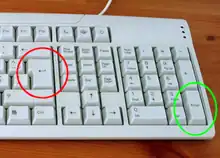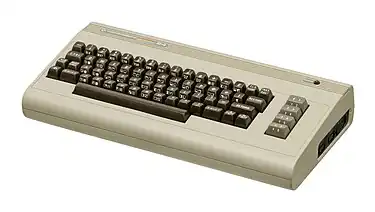
On computer keyboards, the enter key ⌅ Enter and return key ↵ Return are two closely related keys with overlapping and distinct functions dependent on operating system and application.
Functions
The return key has its origins in two typewriter functions: carriage return, which would reset the carriage to the beginning of the line of text, and line feed, which would advance the paper one line downward. These were often combined into a single return key, a convention that continues in modern computer word processing to insert a paragraph break (¶).[1]
The enter key is a computer innovation, which in most cases causes a command line, window form, or dialog box to operate its default function. This is typically to finish an "entry" and begin the desired process, and is usually an alternative to clicking an OK button.[2] Additionally, it can act as the equal to = button in calculator programs. On modern computers both keys generally have all the functions of the other, allowing for either key to be used, or even for them to be combined into a single key, as is the case with most laptops. Microsoft Windows makes no distinction between them whatsoever, and usually both keys are labelled as enter on Windows keyboards with the United States layout. Other operating systems, such as Apple's Darwin-based OSs, generally treat them equivalently while still maintaining the technical and descriptive distinction, allowing applications to treat the two keys differently if necessary.
Location
_Enter_Return.svg.png.webp)
_Enter_Return.svg.png.webp)
The enter key is typically located to the right of the 3 and . keys on the lower right of the numeric keypad, while the return key is situated on the right edge of the main alphanumeric portion of the keyboard. On ISO and JIS keyboards, return is a stepped double-height key spanning the second and third rows, below ⌫ Backspace and above the right-hand ⇧ Shift.[3] On ANSI keyboards it is wider but located on the third row only, as the backslash \ key is located between it and ⌫ Backspace.

Some variants of the ANSI keyboard layout create a double-height return key by subsuming the backslash \ key into it. This alternate form is most popular in Asia, particularly Russia and Korea. However, this requires the relocation of the backslash key and is relatively uncommon on modern keyboards elsewhere.[4]
Keyboard symbols

The return key symbol is U+23CE ⏎ RETURN SYMBOL, an arrow pointing down and leftward; however, rendering of the symbol varies greatly by typeface, with it appearing hollow in some or with an additional initial rightward bar in others. For this reason, U+21B5 ↵ or U+21A9 ↩ are sometimes used instead.[5] On most ISO and other keyboards worldwide the return key is labelled solely with the ⏎ symbol across all platforms. Meanwhile, on ANSI US keyboards it is labelled as ↵ Enter by Windows OEMs (sometimes even without the return symbol) and as return by Apple.[6]
For enter, U+2386 ⎆ ENTER SYMBOL exists in Unicode for the ISO 9995-7 enter key symbol;[7] however, it is infrequently used, one example being the French Canadian keyboard.[8] Windows keyboards worldwide tend to simply label the key with the text ↵ Enter, while Apple uses the symbol ⌤ (U+2324 ⌤ [9] or U+2305 ⌅ ) on ISO and JIS keyboards and the text ⌅ enter on ANSI US keyboards;[10] this is acknowledged by an annotation "enter key" on U+2324 in the Unicode code chart.[7]
History

On IBM's 3270 and 5250 line of terminals, the Enter key was located to the right of the space bar and was used to send the contents of the terminal's buffer to the host computer. The Return key was located in a more standard location and was used to generate a new line.
Apple also took advantage of this situation to create an editable command line environment called a "Worksheet" in the Macintosh Programmer's Workshop, where return was used strictly as a formatting key while enter was used to execute a shell command or series of commands in direct mode. This strict dichotomy has since been relaxed, so that now there are very few situations within macOS where enter and return are not equivalent.
One example of this continued division of use is the type tool in Adobe Photoshop, where the return key produces a new line while the enter key ends editing mode. Another is Mathematica, where the Return key creates a new line, while the Enter key (or Shift-Return) submits the current command for execution.
Historically, many computer models did not have a separate keypad, and only had one button to function as Enter or Return. For example, the Commodore 64 (manufactured from 1982) had only the "Return" key. Most laptop computers continue in this combined tradition.
Before computers, on electric typewriters the "Return" key was kept comparatively large. This is due to the frequency of usage (which also includes the space bar), and therefore, is kept large to reduce the likelihood of finger slips.
See also
References
- ↑ "return key". Cambridge Dictionary. Cambridge University Press. 2020. Retrieved 2020-09-14.
- ↑ "Enter key". PCMag. Ziff Davis, LLC. Retrieved 2020-09-14.
- ↑ "ISO/IEC 9995-1:2009 Information technology — Keyboard layouts for text and office systems — Part 1: General principles governing keyboard layouts". International Organization for Standardization. 2009.
- ↑ "Return key". Deskthority Wiki. Deskthority. Retrieved 2020-09-14.
- ↑ Lee, Xah (2010-09-03). "Keyboard Symbols ⌘ ⏎ ⌫". Σ Xah Code. Retrieved 2020-08-31.
- ↑ "Mac Accessories". Apple Inc. Retrieved 2020-09-14.
- 1 2 "Miscellaneous Technical" (PDF). Unicode Standard. Unicode Consortium.
- ↑ Jobin, Maxime (2012-03-27). "Where are [ and ] in a French keyboard?". Ask Different. Stack Exchange.
- ↑ Apple Computer (2005-04-05). "Map (external version) from Mac OS Keyboard character set to Unicode 4.0 and later". Unicode Consortium.
0x04 0x2324 # UP ARROWHEAD BETWEEN TWO HORIZONTAL BARS # Enter key
- ↑ Weaks, Joe (2005-05-15). "Special Key Symbols". The Macintosh Biblioblog. BlogSpot. Retrieved 2012-09-19.
| Esc | F1 | F2 | F3 | F4 | F5 | F6 | F7 | F8 | F9 | F10 | F11 | F12 | PrtScn/ SysRq |
Scroll Lock |
Pause/ Break |
|||||||||
 |
Insert | Home | PgUp | Num Lock |
∕ | ∗ | − | |||||||||||||||||
| Delete | End | PgDn | 7 | 8 | 9 | + | ||||||||||||||||||
| 4 | 5 | 6 | ||||||||||||||||||||||
| ↑ | 1 | 2 | 3 | Enter | ||||||||||||||||||||
| ← | ↓ | → | 0 Ins |
. Del | ||||||||||||||||||||